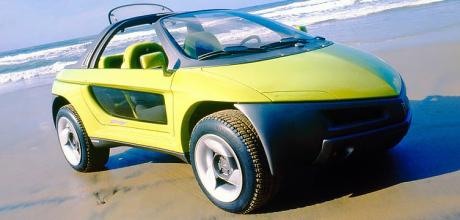1989 Pontiac Stinger
Foreseeing the boom in soft-road and outdoorsy leisure vehicles, Pontiac unveiled the Stinger in the Eighties. It was a concept car that foretold many of the trends that were to come in the following decades…
From here to obscurity — Richard Heseltine’s weird and wonderful American cars from the past.
Pontiac mined a rich seam of form with its concept cars during the Eighties. There were plenty of them, the majority being of the overtly sporty variety. The car pictured here was different from most, though, and it was forgotten quickly. Nevertheless, the Stinger was nothing if not prescient. It was conceived as a ‘cross-over’ vehicle before the term had even been coined. It was aimed at younger drivers who wanted a car that didn’t look like something their dad might drive, but also something that had the practicality of a pick-up or a wagon for hauling their gear should they wish to go hiking, surfing or suchlike of a weekend.

As befitted a concept car it looked pretty far out, but there were plenty of real-world features, some of which accurately foretold the future. Being a one-off, the 1989 confection wasn’t of unitary construction purely for ease of build. The basis was a simple steel chassis with 164.8-inch wheelbase, a skeletal tubular structure being added to which the carbon-fibre body panels were attached. In keeping with a vehicle that was ‘…easily adapted to active lifestyles’, it was equipped with running gear that its makers insisted were up to the task, whether driving on-road or off-piste – it was as at home in urban cityscapes as it was carving through canyons. Power came from a three-litre ‘Iron Duke’ Tech 4 unit, but with a prototype four-valveper- cylinder head. It also featured multi-port fuel injection. According to the brochure, it produced 170bhp at 6500rpm. The Stinger also boasted all-wheel drive and a ‘Pneumatic Active Suspension System’ with driver-adjustable settings for hardness or softness, power being transmitted to the wheels via an AWD set-up borrowed from the Pontiac 6000 STE and SE saloons. The driver could also raise the suspension by up to four inches for off-road use. The application of so many bits from the factory parts bin was trumpeted in press releases which, in itself, was highly unusual for a concept car.

But it was the visuals that sold the project for many onlookers. It was clearly a Pontiac, visual signifiers including the split grille and pop-up headlights, but it had a look all of its own all the same. For starters, there were the stubby overhangs front and rear, and the use of polyurethane glazing in the lower half of the doors. The body panels, meanwhile, were painted in a lurid shade of green with grey highlights, the rolling stock being custom-made ‘tri-bladed’ cast-aluminium wheels shod with bespoke Goodyear tyres. Intriguingly, all the ‘glass’ used in the Stinger, save for the windscreen, was removable, making for a sort of beach buggy-cum-Jeep.
Inside, there were four contoured bucket seats with competition-style harnesses. Each seat could be reconfigured and folded flat to provide a sleeping area. Other conveniences for outdoorsy types included such items as a built-in camping stove, a picnic table and a toolbox. Then there was the electric compass, the telephone built into the driver-side armrest, plus a pull-out drawer which in turn revealed a mobile phone. Oh, and let’s not forget the integral vacuum cleaner, the first-aid kit, the binoculars, the fire extinguisher, and… well, you get the idea. Sadly, Pontiac didn’t follow through and put the Stinger into production, not that it was ever likely to. It did, however, provide ammunition to marketeers within the General Motors division that there was a need for such a vehicle. Pontiac went on to build one, too, but the Aztec didn’t quite hit the mark.
Pontiac’s beachbuggy? Maybe.


